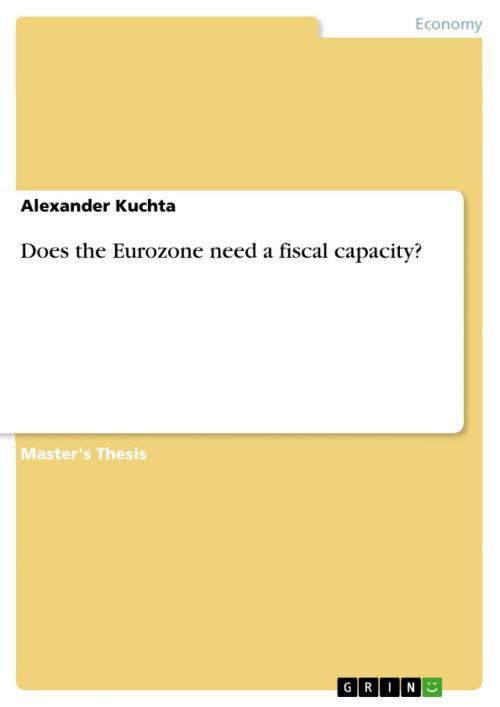| Author: | Alexander Kuchta | ISBN: | 9783668102767 |
| Publisher: | GRIN Verlag | Publication: | December 4, 2015 |
| Imprint: | GRIN Verlag | Language: | English |
| Author: | Alexander Kuchta |
| ISBN: | 9783668102767 |
| Publisher: | GRIN Verlag |
| Publication: | December 4, 2015 |
| Imprint: | GRIN Verlag |
| Language: | English |
Master's Thesis from the year 2015 in the subject Economics - Other, grade: 1,3, University of Frankfurt (Main), language: English, abstract: The European Monetary and Economic Union (EMU) is often described as a house without a roof. It is nice to be in it when the sun is shining but a horrible place to be when it starts to rain. A roof in this case alludes to the fact that the Euro is a currency without a state. MacDougall (1977) has addressed this issue in the 1970's where he highlighted the necessity of a fiscal capacity. He proposed that before a common currency could be introduced, some form of federal budget should be established in order to help aligning the member states more closely to each other. During the first years of the Euro it seemed as if these opinions were wrong. The euro was a stable currency that even threatened the supremacy of the dollar. However, these days are long gone. The financial crisis and the subsequent sovereign debt crisis have revealed that the inherent problems of the euro were covered by immense flows of capital from north to south. When these flows abated the Eurozone was left in a state of large disequilibria without any instruments to cope. As readjustment takes longer than expected, the political, economic and social costs have since then increased strongly (see exemplarily Sinn (2012)). This master thesis picks up on this topic and tackles the question whether or not the Eurozone needs a common budget or transfers mechanism in order to cope with the challenges of a common currency. In order to do so Chapter 2 will explore the optimal currency theory and try to determine how fiscal transfers can help to cope with idiosyncratic shocks. Subsequently, Chapter 3 analyses the roots of the large disequilibria in the EMU. An analysis of the degree of business cycle convergence and inflation differentials is conducted. Chapter 4.1. investigates the role of automatic stabilisers as a shock absorption instrument and tries to determine how much insurance it can provide for the regions in existing federations. In Chapter 4.2. the efficacy of the enacted changes in the EMU financial, fiscal and eco-nomic framework to cope with the existing weaknesses of the EMU structure is determined. , Chapters 4.3, 4.4 and 4.5 are assessing the potential impact of a European tax-benefit systems and European economic agency, transfer mechanism based on a macroeconomic indicator and a European basic unemployment insurance in terms of business cycle conver-gence, countercyclical properties and their potential problems.
Master's Thesis from the year 2015 in the subject Economics - Other, grade: 1,3, University of Frankfurt (Main), language: English, abstract: The European Monetary and Economic Union (EMU) is often described as a house without a roof. It is nice to be in it when the sun is shining but a horrible place to be when it starts to rain. A roof in this case alludes to the fact that the Euro is a currency without a state. MacDougall (1977) has addressed this issue in the 1970's where he highlighted the necessity of a fiscal capacity. He proposed that before a common currency could be introduced, some form of federal budget should be established in order to help aligning the member states more closely to each other. During the first years of the Euro it seemed as if these opinions were wrong. The euro was a stable currency that even threatened the supremacy of the dollar. However, these days are long gone. The financial crisis and the subsequent sovereign debt crisis have revealed that the inherent problems of the euro were covered by immense flows of capital from north to south. When these flows abated the Eurozone was left in a state of large disequilibria without any instruments to cope. As readjustment takes longer than expected, the political, economic and social costs have since then increased strongly (see exemplarily Sinn (2012)). This master thesis picks up on this topic and tackles the question whether or not the Eurozone needs a common budget or transfers mechanism in order to cope with the challenges of a common currency. In order to do so Chapter 2 will explore the optimal currency theory and try to determine how fiscal transfers can help to cope with idiosyncratic shocks. Subsequently, Chapter 3 analyses the roots of the large disequilibria in the EMU. An analysis of the degree of business cycle convergence and inflation differentials is conducted. Chapter 4.1. investigates the role of automatic stabilisers as a shock absorption instrument and tries to determine how much insurance it can provide for the regions in existing federations. In Chapter 4.2. the efficacy of the enacted changes in the EMU financial, fiscal and eco-nomic framework to cope with the existing weaknesses of the EMU structure is determined. , Chapters 4.3, 4.4 and 4.5 are assessing the potential impact of a European tax-benefit systems and European economic agency, transfer mechanism based on a macroeconomic indicator and a European basic unemployment insurance in terms of business cycle conver-gence, countercyclical properties and their potential problems.















